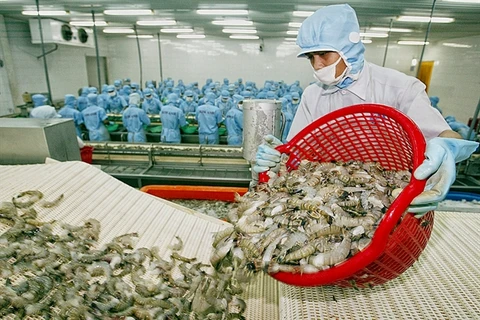 Inside a pangasius fillet processing plant of I.D.I International Development & Investment Corporation.(Photo: VNA)
Inside a pangasius fillet processing plant of I.D.I International Development & Investment Corporation.(Photo: VNA) The seafood industry witnessed a strong recovery after being affected by the COVID-19 pandemic.
In the first seven months of 2022, seafood exports earned nearly 6.7 billion USD, a gain of 35% year-on-year.
The Vietnam Association of Seafood Exporters and Producers (VASEP) expected that in 2022, seafood export turnover can exceed the target of $10 billion, an increase of 12-15% over last year.
However, Nguyen Hoai Nam, deputy general secretary of VASEP, told tinnhanhchungkhoan.vn that businesses are still suffering from the impact and consequences of the pandemic, while high inflation weighs on purchasing power in the country’s seafood consumer markets and higher aqua feed prices.
Production costs and shipping costs are two main pressures that seafood businesses are facing, Nam added.
Of which, production costs, or the high price of aqua feed in particular, causes the price of Vietnamese seafood products to pick up, reducing competitiveness with other countries' products. The expenses of animal feed for pangasius and shrimp account for 65-70% of the cost.
Meanwhile, shipping and labour costs have both increased over the past two years due to issues related to COVID-19, port congestion and soaring fuel prices. The cost of a container going to the US West Coast is currently about 400 million VND (17,054.68 USD) and going to Europe is 10,000-12,000 USD. Other costs such as packaging and chemicals also increased.
Cash flows and credit tightening since the beginning of August are other problems for the industry.
Nam said that some major markets of Vietnamese seafood, such as the US and the European Union (EU), record high inflation, meaning consumers have to limit spending, and the purchasing power of seafood was at risk of decline.
Many importers announced that they do not have orders from now until the end of October. Therefore, businesses are unlikely to have enough cash flow to repay bank loans. And without paying old debts, they will not be able to borrow new loans, affecting purchasing activities of shrimp and fish.
Possibility of deceleration
The business picture in the first seven months of 2022 showed positive growth.
In July, the Vinh Hoan Corporation’s revenue reached nearly 1.2 trillion VND, up nearly 13% month-on-month and 48% on-year.
Many other seafood enterprises recorded big profits in the first six months of 2022 such as the Sao Ta Foods JSC with 161 billion VND in profit, up 42%, while Navico’s profit of 447 billion VND, 5 times higher than the same period last year, and I.D.I International Development & Investment Corporation’s profit was up 2% to 391 billion VND.
However, the story is different in the third quarter of 2022, as VASEP expected it to slow down, with the total export turnover expected to reach about $3 billion, lower than in the second quarter.
One of the reasons is the scarcity of raw materials for shrimp and seafood. Meanwhile, world shrimp demand is forecast to be less positive in the last months of the year.
A leader of a seafood export business said that recently, orders have started to slow down, and consumers' purchasing power is affected by exchange rate fluctuations in the EU, while in the US market, people gradually tighten spending. Some importers reported delayed delivery time of 3-5 months.
Shrimp and pangasius are two key export products of Vietnam’s seafood industry, but difficulties and challenges are inevitable when feed prices are getting higher and competitive pressure emerges from some markets. Recently, China shut down to prevent the spread of COVID-19. As Ecuador and India could not export shrimp to this market, they sold to the US, Canada, Japan, and EU markets.
Even though China has reopened the border, there is still a large amount of shrimp from the two markets, causing Vietnamese shrimp exports to suffer. In the US, Vietnam’s seafood exports in July to this market decreased by 23% over the same period last year.
Regarding fish feed, if in 2020, a 25kg bag of bran cost 330,000 VND, now it has increased to 420,000 VND, while the selling price of much commercial fish has not risen.
With pangasius products, despite favourable market demand, the supply of raw pangasius is not stable.
Chairman of the Vietnam Pangasius Association Duong Nghia Quoc said that pangasius of 0.8 - 1 kg a fish can be exported to the US and EU for 28,000 - 29,000 VND per kg, pangasius of 1.1 - 1.3 kg a head has an export price of 27,000 VND a kg. The prices are significantly higher compared to the cost, so many farmers are hesitant and slow to raise the new crop because it is difficult to earn the desired profit.
According to the Center for Analysis and Investment Advice under SSI Securities, seafood inventories in the main export markets, especially the US, are at a high level due to the large import volume in the first half of 2022. In line with inflationary pressure, seafood exports may decelerate in the third quarter of this year.
VNDIRECT Securities Company forecasts that the gross profit margin of the last two quarters of 2022 of the pangasius and shrimp producers may shrink./.
VNA






















